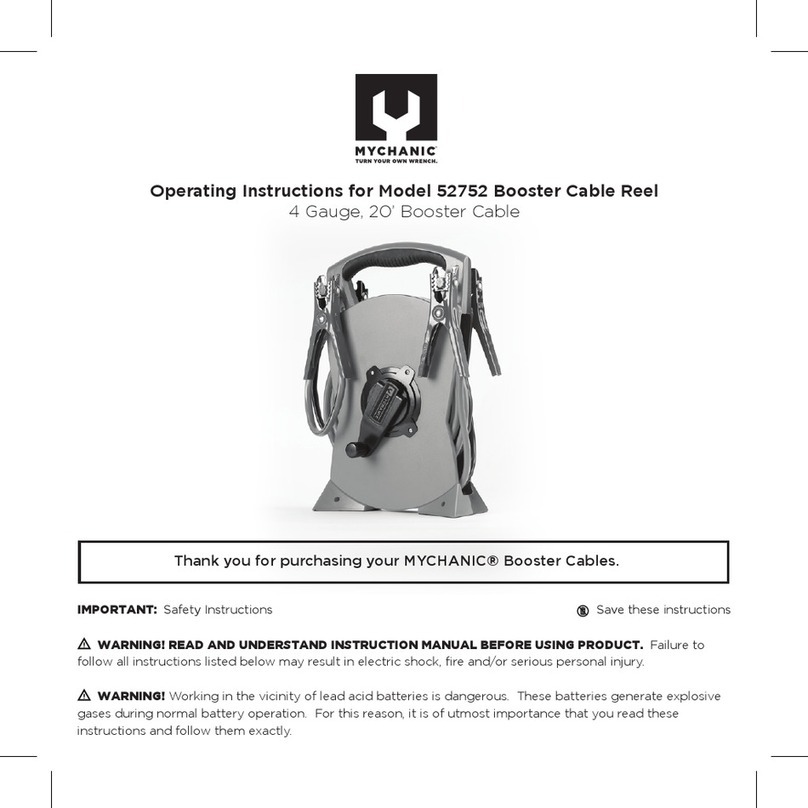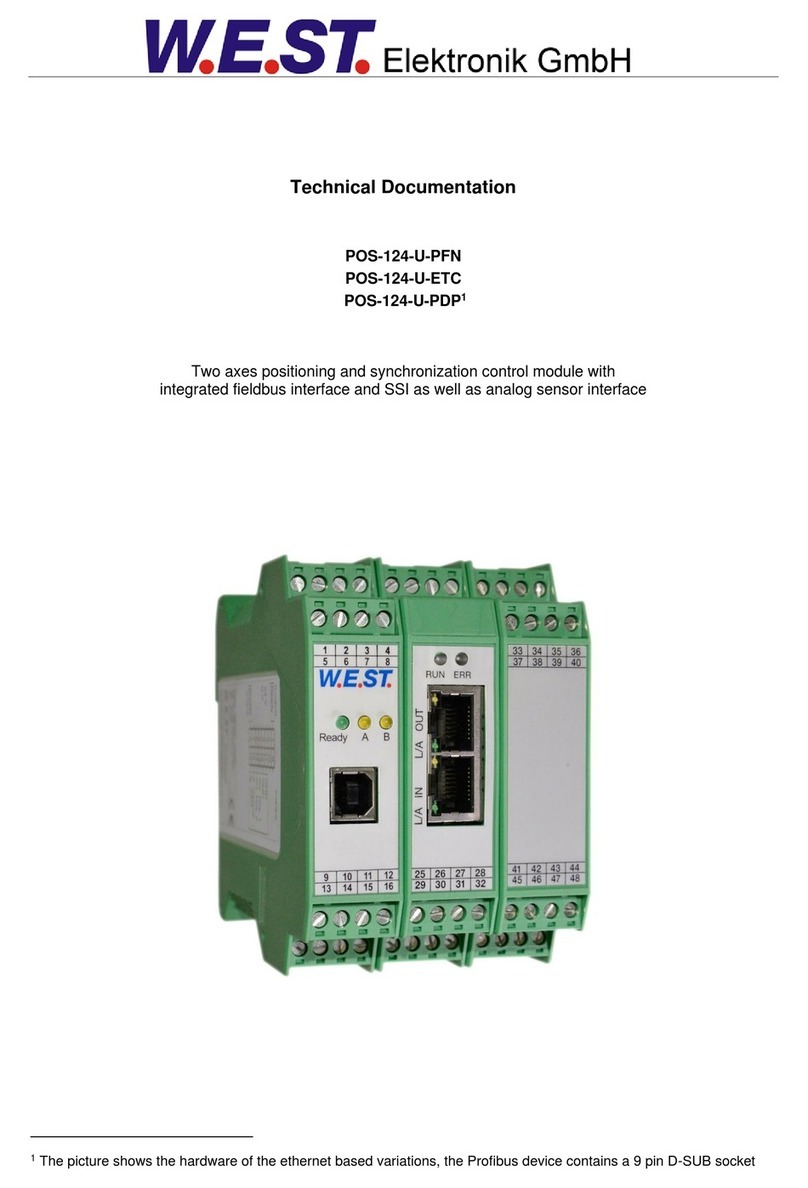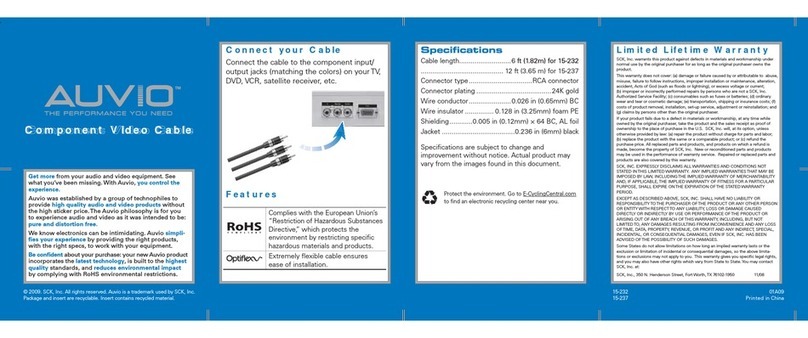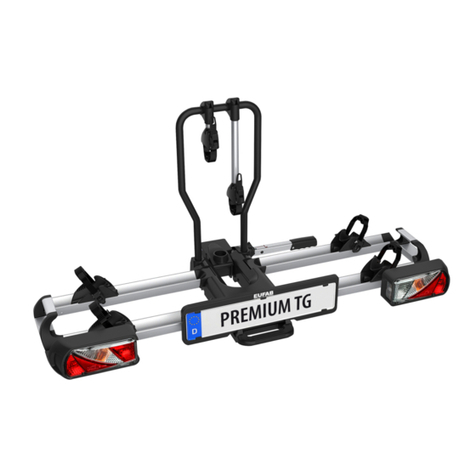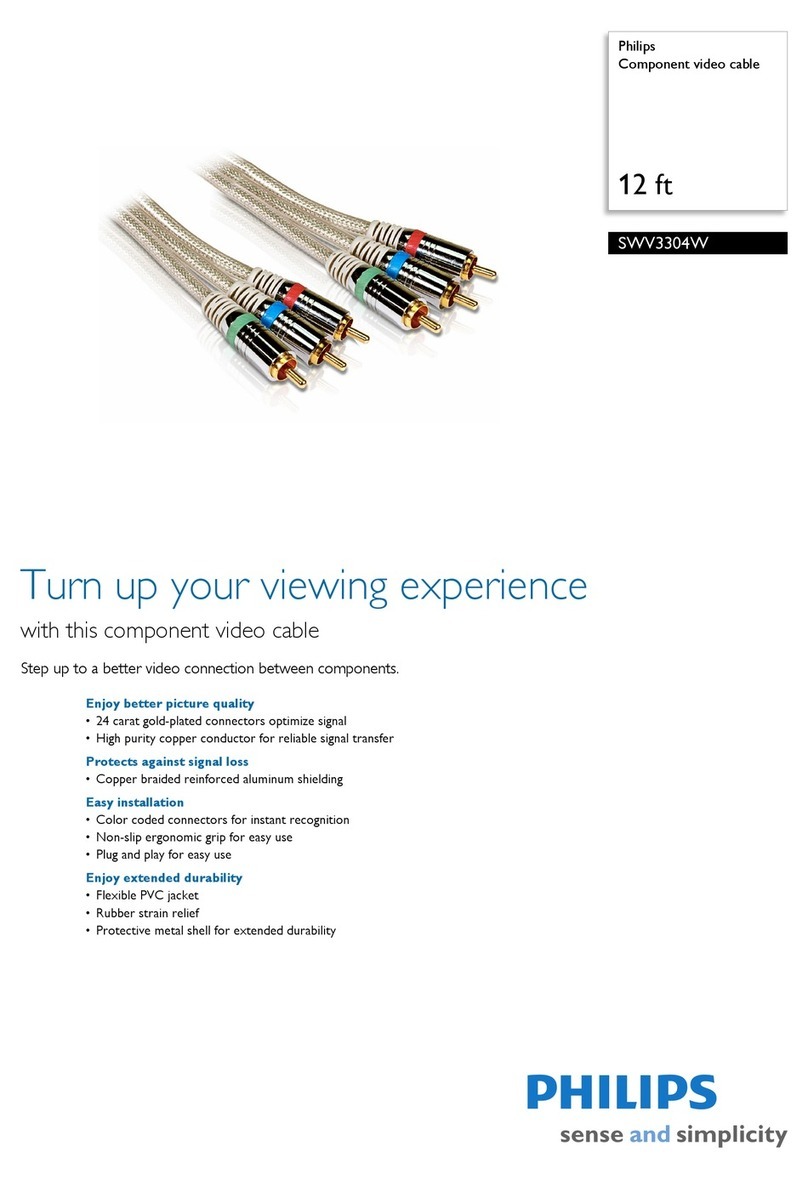Mychanic 52756 User manual

1
WARNING! READ AND UNDERSTAND INSTRUCTION MANUAL BEFORE
USING PRODUCT. Failure to follow all instructions listed below may result in
electric shock, re, and/or serious personal injury.
WARNING: Working in the vicinity of lead acid batteries is dangerous. These
batteries generate explosive gases during normal battery operation. For this
reason, it is of utmost importance that you read these instructions and follow
them exactly. Wear complete eye protection and clothing protection. Avoid
touching the eyes while working near battery.
WARNING: This product contains DEHP, a chemical known to the state of
California to cause birth defects or other reproductive harm.
Operating Instructions for Model 52756 Smart Booster Cable
6 GAUGE, 12’ BOOSTER CABLE WITH
BUILT-IN INDICATORS
Thank you for purchasing your MYCHANIC® Smart Booster Cables.
Save these directions for future reference.

2
SAFETY INSTRUCTIONS
General Safety
• Use only as intended. It will do the job better and with less
likelihood of a risk of injury when used only at the rate for which it
was designed.
• Inspect before every use; do not use if any parts or the wire coating
are loose or damaged.
• Consult your automobile owner’s manual and follow all instructions.
Work Area Safety
• Avoid dangerous environments. Do not use cables in damp or wet
locations or in the rain.
• Keep children, pets, and bystanders away while operating cables.
Distractions can cause you to lose control of the tool, injuring
yourself or others. Protect others in the work area from debris such
as sparks. Provide barriers as needed.
• Store idle cables indoors. When not in use, cables should be stored
indoors in dry and high or locked-up places – out of reach of
children.
• Do not abuse the cord. Keep cord away from heat, oil, and
sharp edges.
• Do not operate power tools in explosive atmospheres, such as in
the presence of ammable liquids, gases, or dust. This tool may
create sparks which may ignite the dust or fumes.
• Make sure the work area is well ventilated. Never operate in an
enclosed space.
• WARNING: Be extra cautious to reduce risk of dropping a metal
tool onto the battery. It is capable of producing a spark or
short-circuiting the battery or other electrical parts and causing an
explosion.
Personal Safety
• WARNING: First Aid Measures: Liquid ejected from the battery
may cause irritation or burns.
o Skin: If battery acid comes in contact with skin, rinse
immediately with water, then wash thoroughly with soap
and water. If redness, pain, or irritation occurs, seek
immediate medical attention.
o Eyes: If battery acid comes in contact with eyes, ush eyes
immediately for a minimum of 15 minutes and seek
immediate medical attention.
• Stay alert, watch what you are doing, and use common sense

3
when operating booster cables. Do not use cables while you are
tired or under the inuence of alcohol, drugs, or medication. A
moment of inattention while operating cables may result in serious
personal injury, shock, or re.
• Dress properly. Do not wear loose clothing or jewelry. They can be
caught in moving parts. Rubber gloves and substantial, non-skid
footwear are recommended when working outdoors. Wear
protective hair covering to contain long hair.
• Use safety glasses and other safety equipment. Use safety goggles
or safety glasses with side shields, complying with applicable safety
standards and, when needed, a face shield. Also, use face or dust
masks if operation is dusty. This applies to all persons in the
work area.
• WARNING NEVER smoke or allow a spark or ame in the
vicinity of battery or engine.
Prior to Jumpstarting
This product is intended for consumer use in boosting a stalled vehicle bat-
tery only. Please use this product as an auxiliary tool only. It can be used in
emergencies, but it is recommended that you take your vehicle to a licensed
service station for long term repairs. Do not use the tool for applications
other than those specied herein.
CAUTION: Both the battery to be jumped and the booster source (battery
or another type of external power source) must be of the same voltage (6,
12, etc.).
• Position the vehicle with the booster battery (or other power
source) adjacent to the vehicle with the discharged battery so that
the connection of booster cables between both vehicles is
made easily.
NOTE: Make certain vehicles do not touch each other.
• Turn off all the electrical loads on both vehicles. Set the parking
brake. Place automatic transmissions in “PARK” and manual
transmissions in “NEUTRAL.”
• Determine whether the discharged battery has the negative (-) or
positive (+) terminal connected to the ground. The ground lead is
connected to the engine block, vehicle frame, or some other
good metallic ground – do not connect to the carburetor or fuel
lines. The battery terminal connected to the starter is the one
INSTRUCTIONS FOR USE

4
which is not grounded. All vehicles manufactured in the U.S.A.
after 1955 have the negative battery terminal grounded. All
European and Asian passenger vehicles have been negative
ground since 1971.
• Vent caps are to be tight and level on both batteries. Place a
damp cloth over any vent caps on each battery, making certain
it is clear of fan blades, belts, and other moving parts. Connect the
batteries as specied on the information tag attached to the
battery booster cable set.
• WARNING Do not allow red and black cable clamps to touch
each other or same metal object during use. This could produce
sparks which can lead to re or explosion.
Instructions for Jumpstarting an Engine
WARNING – BATTERIES PRODUCE EXPLOSIVE GASES.
NOTE: consult automobile owner’s manual and follow all instructions.
SHIELD EYES AND FACE FROM BATTERIES AT ALL TIMES. BE SURE
VENT CAPS ARE TIGHT AND LEVEL. PLACE DAMP CLOTH OVER ANY
VENT CAPS ON BOTH BATTERIES. HANDLE CLOTH CAREFULLY –
DO NOT ALLOW CLOTH TO COME IN CONTACT WITH EYES, SKIN OR
CLOTHING. BE SURE VEHICLES DO NOT TOUCH AND BOTH ELECTRI-
CAL SYSTEMS ARE OFF AND THE SAME VOLTAGE.
Be careful to avoid moving fan blades.
Check polarity of battery posts. POSITIVE (POS, P, +) battery post usually
has larger diameter than NEGATIVE (NEG, N, -) post.
Determine which post of battery is grounded (connected) to the chassis. If
negative post is grounded, connect clamps in order shown in top diagram
and as described for connecting clamps with a grounded negative post.
If positive post is grounded, connect clamps in order shown in bottom
diagram and as described for connecting clamps with a grounded positive
post.
NOTE: Regardless of the polarity of the system, always connect the
short end of the wires, indicated by the arrow on the smart indica-
tor system, to the dead battery. This will allow the voltage indicator
to work properly.

5
If negative post is grounded:
1) Connect positive (+) cable to positive (+) terminal of
discharged battery wired to starter or solenoid.
2) Connect other end of positive cable to the positive terminal of
the booster battery.
3) Connect second cable (negative) to the other terminal
(negative) of booster battery.
4) MAKE FINAL CONNECTION ON ENGINE BLOCK (OR
CHASSIS) OF STALLED VEHICLE (NOT NEGATIVE POST)
AWAY FROM THE BATTERY AND STAND BACK.
If positive post is grounded:
1) Connect negative (-) cable to negative (-) terminal of
discharged battery wired to starter or solenoid.
2) Connect other end of negative cable to the negative terminal
of the booster battery.
3) Connect second cable (positive) to the other terminal
(positive) of booster battery.
4) MAKE FINAL CONNECTION ON ENGINE BLOCK (OR
CHASSIS) OF STALLED VEHICLE (NOT POSITIVE POST)
AWAY FROM THE BATTERY AND STAND BACK.
-
+
-
+
RED
BLACK -
+
-
+
4
4

6
Start vehicle and crank the engine in 2-3 second intervals. Do not crank
the engine for more than 5 seconds. Allow the booster battery to cool
down after each boost.
If vehicle fails to start, turn OFF the ignition, disconnect the booster cable
leads, and contact a qualied technician to investigate why the engine did
not start.
Finally, remove cables in reverse order of connection by disconnecting
the engine block (grounded) connection of the formerly stalled vehicle
rst, followed by the second post to which the cables were attached on
the booster battery, followed by the rst post to which the cables were
attached on the booster battery, and nally the post on the formerly dis-
charged battery.
WARNING Procedure not specically explained in the manual must be
performed only by a qualied technician.
Make sure all four clamps are not connected to a wire or terminal before
performing maintenance.
Allow contacts to cool down before handling. Safety gloves are strongly
recommended.
After use, wipe the contacts clean with a dry cloth to remove any oil,
liquid, or other debris from the surface of the contacts. Do not use any
industrial cleaners or solvents as this may corrode or damage the contacts
or coating.
Use of the Smart Indicator System
When the smart booster cable system is applied correctly with the short
end of the cords attached to the dead battery, the smart system will acti-
vate properly.
The remaining voltage of the dead battery will appear on the digital dis-
play. The following table will help determine what service is required.
MAINTENANCE

7
The smart dot indicator also has a built in reverse polarity alarm.
Regardless of the grounding of the battery system, if the clamps for either
the dead battery or the booster battery are connected to the wrong polar-
ity post (negative to positive and positive to negative), the red LED will
activate and you will hear an audible tone. Please disconnect the cables
immediately and reconnect them in the proper alignment according to the
diagram and instructions above before proceeding.
WARNING: Failure to disconnect the clamps could result in
overheating and injury.
WARNING: The smart indicator system does NOT have a built in short
circuit protection. You must still take care not to touch the clamps to one
another or to the same conductive object when in operation.
Volts
Remaining
Outside
Temperature Action
>12 Any
The problem is not with your battery.
Consult a technician to diagnose why
your vehicle will not start.
5-12 Any Jump starting your battery may help
your vehicle to start.
3-5 Above freezing
Jump starting your battery may help
your vehicle to start. If it does not
start, your battery may need to be
replaced or you may need to consult
a qualied technician.
3-5 Below freezing
Jump starting your battery will prob-
ably not help your vehicle to start in
these conditions. Please move the
vehicle to a warmer location or wait
for conditions to change and then try
again. If it still does not start, your
battery may need to be replaced or
you may need to consult a qualied
technician.
<3 Any Your battery will need to be replaced.
Consult a qualied technician.

8
The WARNING symbol indicates a potentially hazardous situation
which, if not avoided, could result in death or serious injury.
Caution! Used without the safety alert symbol indicates potentially hazard-
ous situation which, if not avoided, may result in property damage.
Cable length: 12 feet (3.65 meters)
Maximum Amp Rating: 200
Maximum Volt Rating: 12
Minimum Temperature: -13°F (-25°C)
MANUFACTURED BY DELK
Nashville, TN 37209
www.mychanic.us
© 2016. DELK, MYCHANIC, TURN YOUR OWN WRENCH and the
MYCHANIC logo are registered trademarks of DELK.
Remaining Temperature
EXPLANATION OF SYMBOLS
SPECIFICATIONS

9
ADVERTENCIA: LEA Y COMPRENDA EL MANUAL DE INSTRUCCIONES ANTES DE
UTILIZAR EL PRODUCTO. No seguir todas las instrucciones que se mencionan a
continuación puede dar como resultado una descarga eléctrica, incendio, y/o lesiones
personales graves.
ADVERTENCIA: Trabajar cerca de baterías de plomo y ácido es peligroso. Estas baterías
generan gases explosivos durante su funcionamiento normal. Por este motivo, es de suma
importancia que lea estas instrucciones y las siga con exactitud. Utilice protección visual
completa y ropa protectora. Evite tocarse los ojos mientras trabaja cerca de la batería.
ADVERTENCIA : Este producto contiene DEHP, una sustancia química que es de cono-
cimiento público en el estado de California por causar malformaciones congénitas u otros
daños reproductivos.
Instrucciones operativas para el cable de refuerzo inteligente Modelo 52756
CALIBRE 6, CABLE DE REFUERZO DE 12’ (3.65M)
CON INDICADORES INCORPORADOS
Gracias por comprar sus cables de refuerzo inteligentes MYCHANIC®.
Guarde estas instrucciones.
IMPORTANTE: Instrucciones de seguridad

10
INSTRUCCIONES DE SEGURIDAD
Seguridad General
• Usar solo como está pensado. Hará mejor el trabajo y con menor
probabilidad de un riesgo de lesión cuando se use solo al índice
para el que fue diseñado.
• Inspecciónelo antes de cada uso; no lo utilice si cualquier parte del
mismo o el recubrimiento del cable están sueltos o dañados.
• Consulte el manual del propietario de su automóvil y siga todas las
instrucciones.
Área de Trabajo Segura
• Evite los ambientes peligrosos. No utilice los cables en lugares
mojados, húmedos o bajo la lluvia.
• Mantenga alejados a los niños, las mascotas y los transeúntes
mientras opera los cables. Las distracciones pueden hacer que
pierda el control de la herramienta y se lesione usted mismo o a
otras personas. Proteja a las demás personas que se encuentran
en el área de trabajo de los desechos, como las chispas.
Proporciona barreras según sea necesario.
• Almacene los cables en reposo en interiores. Cuando no estén
siendo utilizados, los cables deberían almacenarse en interiores
en lugares secos y altos o cerrados bajo llave, fuera del alcance de
los niños.
• No haga un mal uso del cable. Mantenga el cable alejado del calor,
el aceite y los extremos losos.
• No opere con herramientas eléctricas en ambientes explosivos,
como en presencia de líquidos, gases o polvos inamables.
Esta herramienta puede crear chispas que pueden encender el
polvo o gases.
• Asegúrese de que el área de trabajo se encuentre bien ventilada.
Jamás opere en un espacio cerrado.
• ADVERTENCIA Sea extremadamente precavido para reducir el
riesgo de dejar caer una herramienta metálica sobre la batería.
Es capaz de producir una chispa o cortocircuito en la batería o
demás piezas eléctricas y causar una explosión.
Seguridad Personal
• ADVERTENCIA: Medidas de primeros auxilios: El líquido que
sale de la batería puede causar irritación o quemaduras.
o Piel: si el ácido de la batería entra en contacto con la piel,
enjuague de inmediato con agua, luego lave bien con agua
y jabón. Si experimenta enrojecimiento, dolor o irritación,
obtenga atención médica de inmediato.

11
o Ojos: si el ácido de la batería entra en contacto con los
ojos, enjuague de inmediato por al menos 15 minutos y
obtenga atención médica de inmediato.
• Manténgase alerta, observe lo que hace y utilice el sentido
común al operar cables de refuerzo. No utilice los cables
mientras se encuentre cansado o bajo la inuencia del
alcohol, drogas o medicamentos. Un momento de falta de
atención al operar los cables puede dar como resultado una
lesión personal grave, una descarga o un incendio.
• Vístase adecuadamente. No use ropa suelta ni joyas. Pueden
quedar atascadas en las piezas móviles. Se recomienda el uso
de guantes de goma y calzado antideslizante resistente al
trabajar en exteriores. Use una coa protectora para contener
el cabello largo.
• Use anteojos de seguridad y otros equipos de seguridad. Use
gafas tipo goggles o anteojos de seguridad con protecciones
laterales que cumplan con las normas de seguridad
aplicables y, cuando fuera necesario, una máscara de
protección facial. Además, use máscaras de protección facial o
contra el polvo si la operación produce polvo. Esto se aplica a
todas las personas que se encuentren en el área de trabajo.
• ADVERTENCIA NUNCA fume ni permita la presencia de
chispas o llamas cerca de la batería o del motor.
Antes del Arranque
Este producto está diseñado para uso exclusivo del consumidor como
refuerzo de una batería de automóvil agotada. Utilice este producto
solamente como herramienta auxiliar. Se puede utilizar en emergencias,
pero se recomienda que lleve su vehículo a una estación de servicio
autorizada para realizar reparaciones a largo plazo. No utilice la
herramienta para aplicaciones diferentes a las que se especican en el
presente documento.
PRECAUCIÓN: Tanto la batería que va a arrancar como la fuente de
refuerzo (batería u otro tipo de fuente de energía eléctrica externa) deben
ser del mismo voltaje (6, 12, etc.).
• Coloque el vehículo con la batería de refuerzo (u otra fuente de
INSTRUCCIONES DE USO

12
energía eléctrica) cerca del vehículo con la batería descargada
para que la conexión de los cables de refuerzo entre ambos
vehículos se pueda realizar con facilidad.
NOTA: Asegúrese de que los vehículos no estén en contacto.
• Apague todas las cargas eléctricas en ambos vehículos.
Accione el freno de mano. Coloque los cambios automáticos
en “ESTACIONAMIENTO” y los cambios manuales en “PUNTO
MUERTO”.
• Determine si la batería descargada tiene la terminal negativa (-)
o positiva (+) conectada a tierra. La toma a tierra está
conectada al bloque del motor, al chasis del vehículo o a
alguna otra supercie metálica; no conecte al carburador u
otros conductos de combustible. El terminal de la batería
conectado al arranque es el que no está conectado a tierra.
Todos los vehículos fabricados en EE. UU. después de 1955
tienen la terminal negativa de la batería conectada a tierra.
Todos los vehículos de pasajeros europeos y asiáticos tienen
toma a tierra negativa desde 1971.
• Las tapas de ventilación deben estar ajustadas y niveladas en
ambas baterías. Coloque un paño mojado sobre todas las
tapas de ventilación de cada batería, asegurándose de que
esté libre de paletas de ventiladores, correas y otras piezas
móviles. Conecte las baterías según se especica en la
etiqueta de información que incluye el equipo de cables de
refuerzo para batería.
• ADVERTENCIA No permita que las abrazaderas de los
cables rojo y negro entren en contacto entre sí o el mismo
objeto metálico durante el uso. Esto podría producir chispas
que pueden causar un incendio o explosión.
Instrucciones para el Arranque del Motor
ADVERTENCIA – LAS BATERÍAS PRODUCEN GASES EXPLOSIVOS.
NOTA: Consulte el manual del propietario de su automóvil y siga todas las
instrucciones.
PROTEJA LOS OJOS Y EL ROSTRO DE LAS BATERÍAS EN TODO
MOMENTO. ASEGÚRESE DE QUE LAS TAPAS DE VENTILACIÓN ESTÉN
AJUSTADAS Y NIVELADAS. COLOQUE UN PAÑO HÚMEDO SOBRE
TODAS LAS TAPAS DE VENTILACIÓN EN AMBAS BATERÍAS. MANIPULE
EL PAÑO CON CUIDADO - NO PERMITA QUE EL PAÑO ENTRE EN
CONTACTO CON LOS OJOS, LA PIEL O LA ROPA. ASEGÚRESE DE
QUE LOS VEHÍCULOS NO ESTÉN EN CONTACTO ENTRE SÍ Y DE QUE

13
AMBOS SISTEMAS ELÉCTRICOS ESTÉN APAGADOS Y SEAN DEL MISMO
VOLTAJE.
Tenga cuidado de evitar las paletas móviles de los ventiladores.
Compruebe la polaridad de los bornes de la batería. El borne POSITIVO
(POS, P, +) de la batería usualmente tiene un diámetro mayor que el borne
NEGATIVO (NEG, N, -).
Determine qué poste de la batería tiene toma (está conectado) al chasis.
Si el borne negativo tiene toma a tierra, conecte las abrazaderas en el
orden que se muestra en el diagrama de arriba y según se describe para
conectar las abrazaderas con un borne negativo con toma a tierra. Si el
borne positivo tiene toma a tierra, conecte las abrazaderas en el orden que
se muestra en el diagrama de abajo y según se describe para conectar las
abrazaderas con un borne positivo con toma a tierra.
Si el borne negativo tiene toma a tierra:
1) Conecte el cable positivo (+) a la terminal positiva (+) de la
batería descargada conectada al arranque o solenoide.
2) Conecte el otro extremo del cable positivo a la terminal
positiva de la batería de refuerzo.
3) Conecte el segundo cable (negativo) a la otra terminal
(negativa) de la batería de refuerzo.
4) REALICE LA CONEXIÓN FINAL EN EL BLOQUE (O CHASIS)
DEL MOTOR DEL VEHÍCULO SIN BATERÍA (NO EN EL BORNE
NEGATIVO) LEJOS DE LA BATERÍA Y ALÉJESE.
Si el borne positivo tiene toma a tierra:
1) Conecte el cable negativo (-) a la terminal negativa (-) de la
batería descargada conectada al arranque o solenoide.
2) Conecte el otro extremo del cable negativo a la terminal
negativa de la batería de refuerzo.
3) Conecte el segundo cable (positivo) a la otra terminal
(positiva) de la batería de refuerzo.
4) REALICE LA CONEXIÓN FINAL EN EL BLOQUE (O CHASIS)
DEL MOTOR DEL VEHÍCULO SIN BATERÍA (NO EN EL
BORNE POSITIVO) LEJOS DE LA BATERÍA Y ALÉJESE.
NOTA: Sin importar la polaridad del sistema, conecte siempre el
extremo corto de los cables, indicado por la echa en el sistema
indicador inteligente, a la batería muerta. Esto permitirá que el indi-
cador de voltaje funcione adecuadamente.

14
Encienda el vehículo e intente arrancar el motor en intervalos de 2 a 3
segundos. No intente arrancar el motor por más de 5 segundos. Deje que la
batería de refuerzo se enfríe después de cada refuerzo.
Si el vehículo no arranca, APAGUE el encendido, desconecte los cables
del sistema de arranque y comuníquese con un técnico calicado para
investigar por qué el motor no arrancó.
Por último, retire los cables en el orden inverso al de la conexión,
desconectando la conexión al bloque del motor (conectado a tierra) del
vehículo que inicialmente tenía la batería agotada, luego el segundo borne
al que los cables están conectados en la batería de refuerzo, seguido del
primer borne al que estuvieron conectados los cables en la batería de
refuerzo, y por último el borne de la batería originalmente descargada.
ADVERTENCIA El procedimiento no explicado especícamente en el
manual debe ser realizado solo por un técnico calicado.
Asegúrese de que las cuatro abrazaderas no se encuentren conectadas a
4
CONEXIÓN
A TIERRA
NEGATIVA
MANTENIMIENTO

15
un cable o terminal antes de realizar el mantenimiento.
Deje que se enfríen los contactos antes de manipularlos. Se recomienda
rmemente el uso de guantes de seguridad.
Luego del uso, limpie los contactos con un paño limpio y seco para eliminar
aceites, líquidos u otros desechos de la supercie de los contactos. No
utilice limpiadores industriales ni solventes ya que esto puede corroer o
dañar los contactos o el recubrimiento.
Uso del Sistema Indicador Inteligente
Cuando el sistema de cable de refuerzo inteligente se aplica correctamente
con el extremo corto de los cables conectado a la batería muerta, el sistema
inteligente se activará adecuadamente.
El voltaje restante de la batería muerta aparecerá en la pantalla digital. La
siguiente tabla ayudará a determinar qué servicio se necesita.
Voltios
Restantes
Temperatura
Exterior Acción
>12 Cualquiera
El problema no es su batería. Con-
sulte un técnico para que diagnos-
tique por qué su vehículo no enci-
ende.
5-12 Cualquiera Arrancar su batería puede ayudar a
que su vehículo arranque.
3-5
Por encima de la
temp. de conge-
lamiento
Arrancar su batería puede ayudar a
que su vehículo arranque. Si no ar-
ranca, es posible que su batería deba
reemplazarse o es posible que deba
consultar con un técnico calicado.
3-5 Debajo de la temp.
de congelamiento
Es probable que arrancar su batería
no ayude a que su vehículo arranque
en esas condiciones. Mueva el vehí-
culo a una ubicación más caliente o
espere a que las condiciones cambien
y luego vuelva a intentarlo. Si aún
no arranca, es posible que su batería
deba reemplazarse o es posible
que deba consultar con un técnico
calicado.
<3 Cualquiera Se debe reemplazar su batería. Con-
sulte con un técnico calicado.

16
El indicador inteligente de punto también cuenta con una alarma de po-
laridad inversa incorporada. Sin importar la conexión a tierra del sistema
de batería, si las abrazaderas ya sea para la batería muerta o la batería de
refuerzo están conectadas al borne de la polaridad incorrecta (negativo a
positivo y positivo a negativo), la luz LED roja se encenderá y escuchará
un tono audible. Desconecte los cables inmediatamente y reconéctelos en
el alineamiento adecuado de acuerdo con el diagrama y las instrucciones
anteriores antes de proceder.
ADVERTENCIA: No desconectar las abrazaderas puede resultar en un
sobrecalentamiento y una lesión.
ADVERTENCIA: El sistema indicador inteligente NO cuenta con una
protección en caso de corto circuito incorporada. Aun así debe tener
cuidado de no hacer que las abrazaderas se toquen una con otra o al mis-
mo objeto conductor cuando estén en funcionamiento.
El símbolo ADVERTENCIA indica una posible situación de peligro la
cual, si no se evita, podría dar como resultado la muerte o una lesión grave.
¡Precaución! El uso sin el símbolo de alerta de seguridad, indica una posible
situación peligrosa la cual, si no se evita, puede dar como resultado daños a
la propiedad.
Longitud del cable: 12 pies (3.65 metros)
Máxima clasicación de amperaje: 200
Máxima clasicación de voltaje: 12
Temperatura mínima: -25°C (-13°F)
FABRICADO POR DELK
Nashville, TN 37209
www.mychanic.us
© 2016. DELK, MYCHANIC, TURN YOUR OWN WRENCH y el logotipo de
MYCHANIC son marcas registradas de DELK.
EXPLICACIÓN DE LOS SÍMBOLOS
ESPECIFICACIONES
Table of contents
Languages:
Other Mychanic Cables And Connectors manuals
Popular Cables And Connectors manuals by other brands
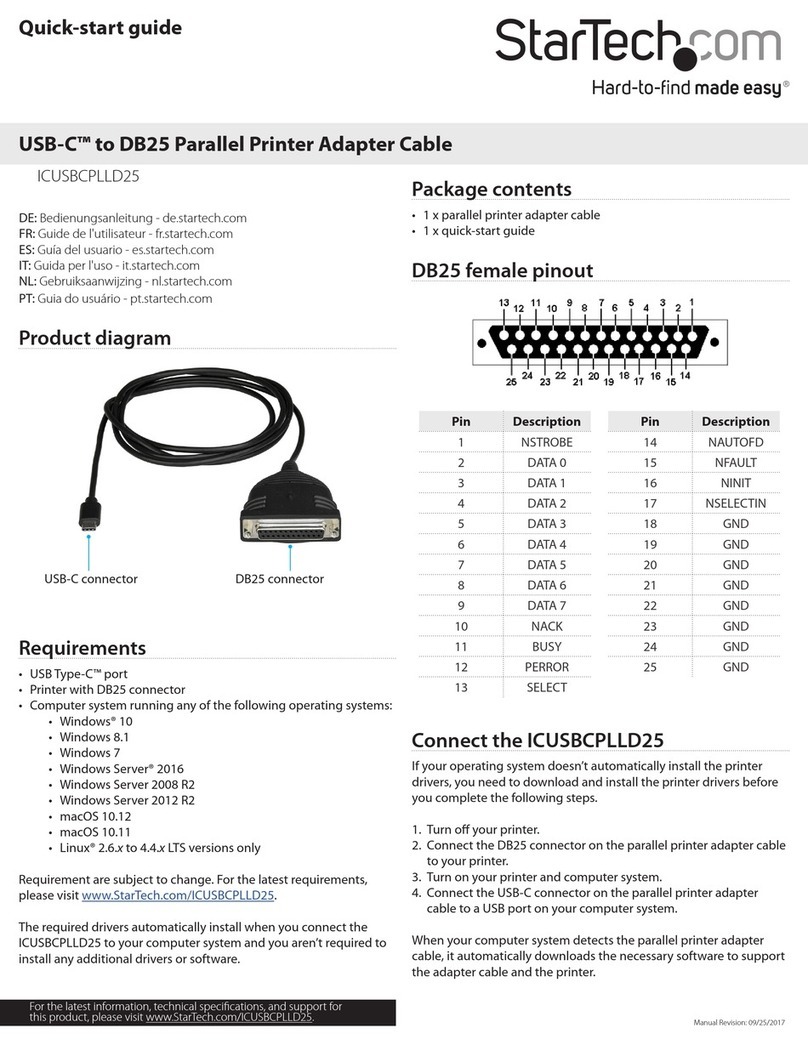
StarTech.com
StarTech.com ICUSBCPLLD25 quick start guide

Leviton
Leviton JCC Skytile manual
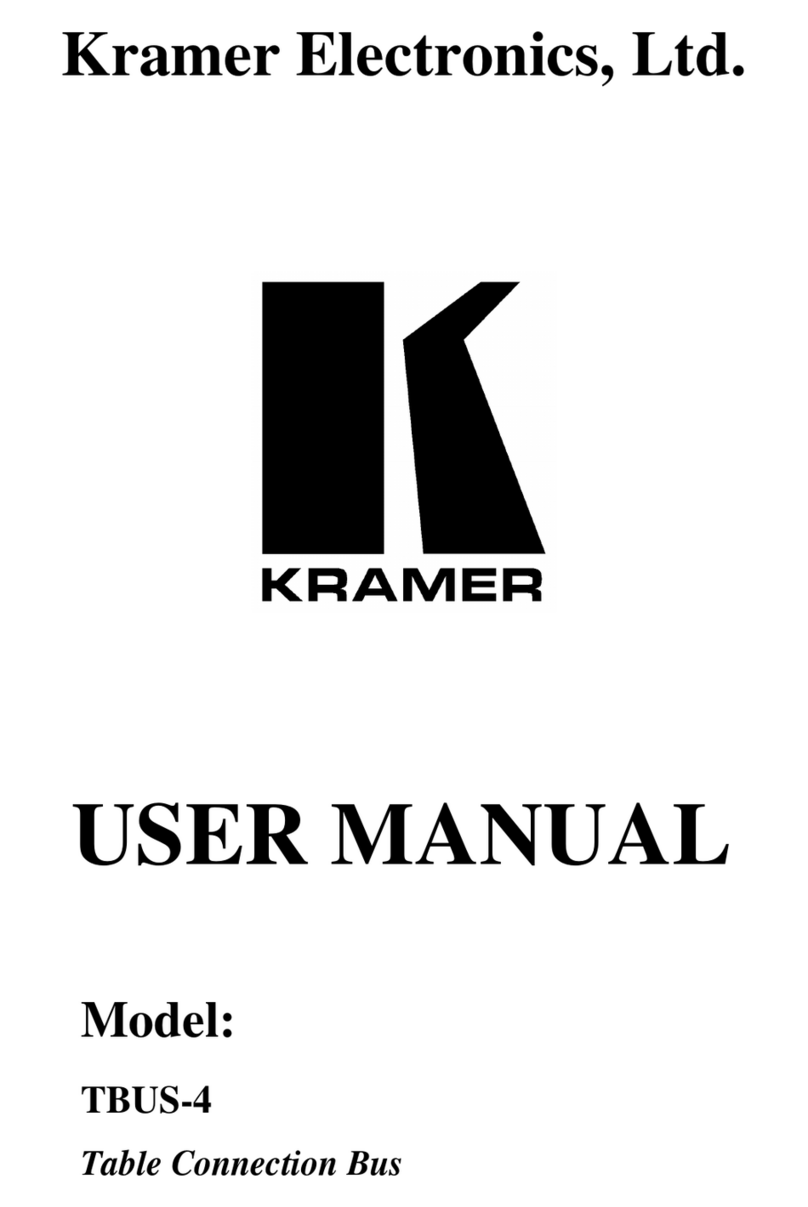
Kramer
Kramer TBUS-4 user manual
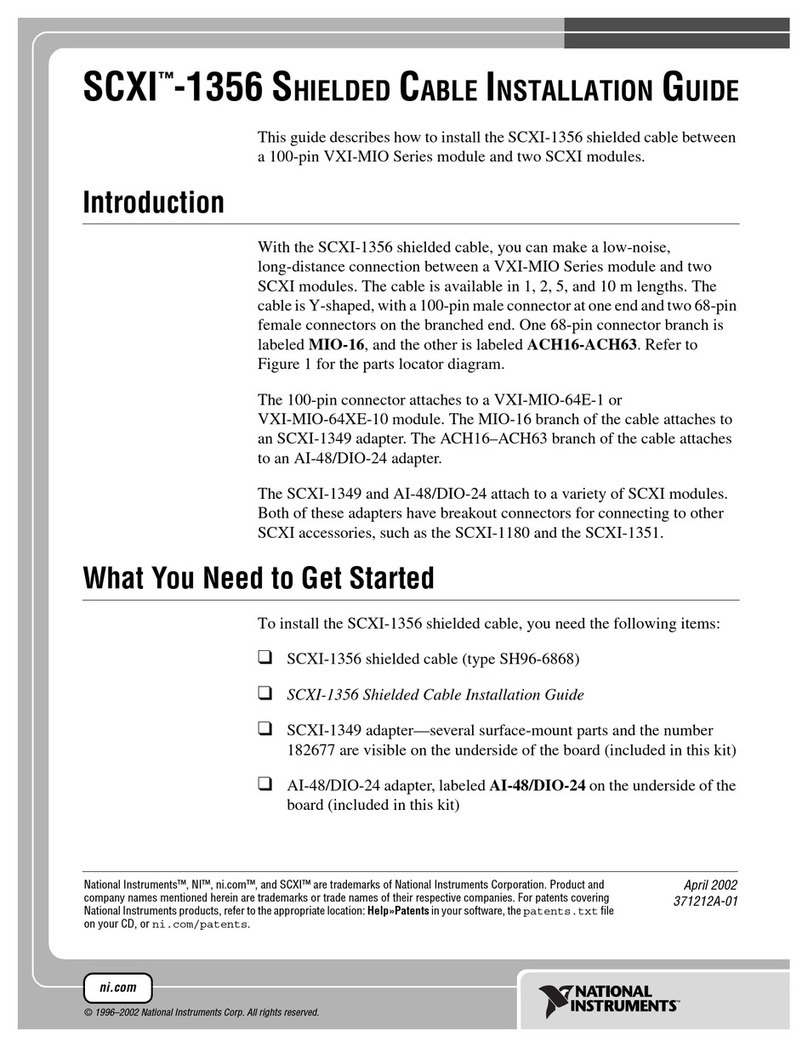
National Instruments
National Instruments SCXI-1356 installation guide
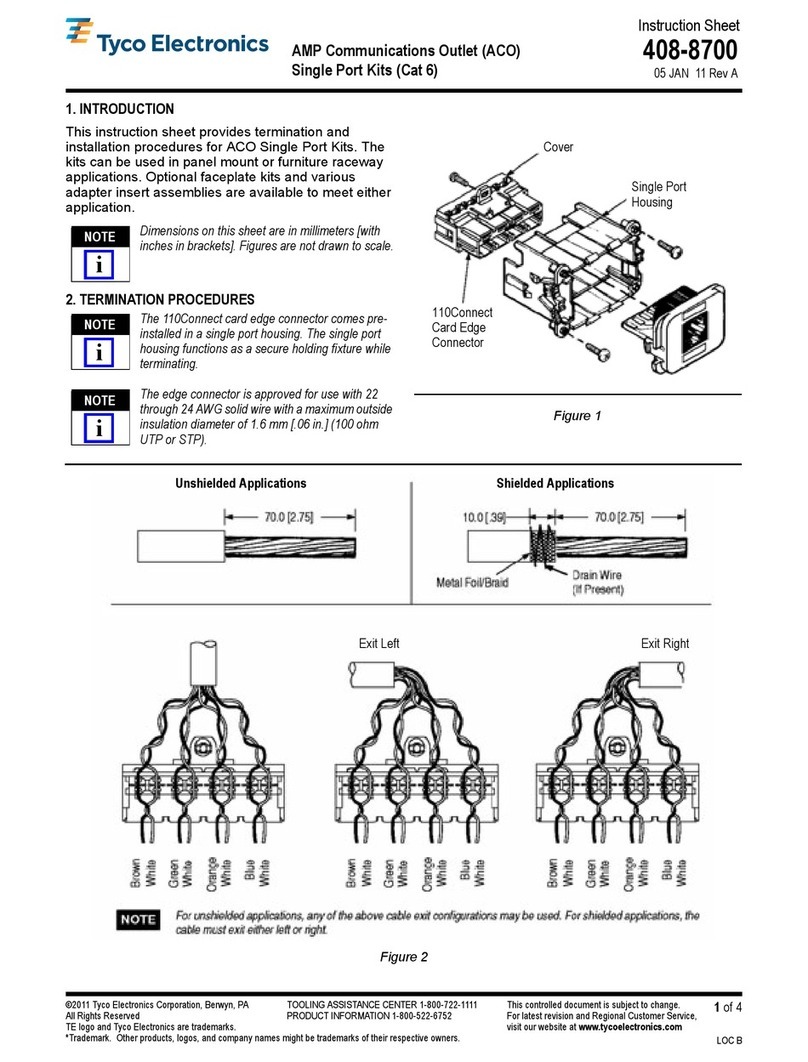
Tyco Electronics
Tyco Electronics ACO Single Port Kits instruction sheet
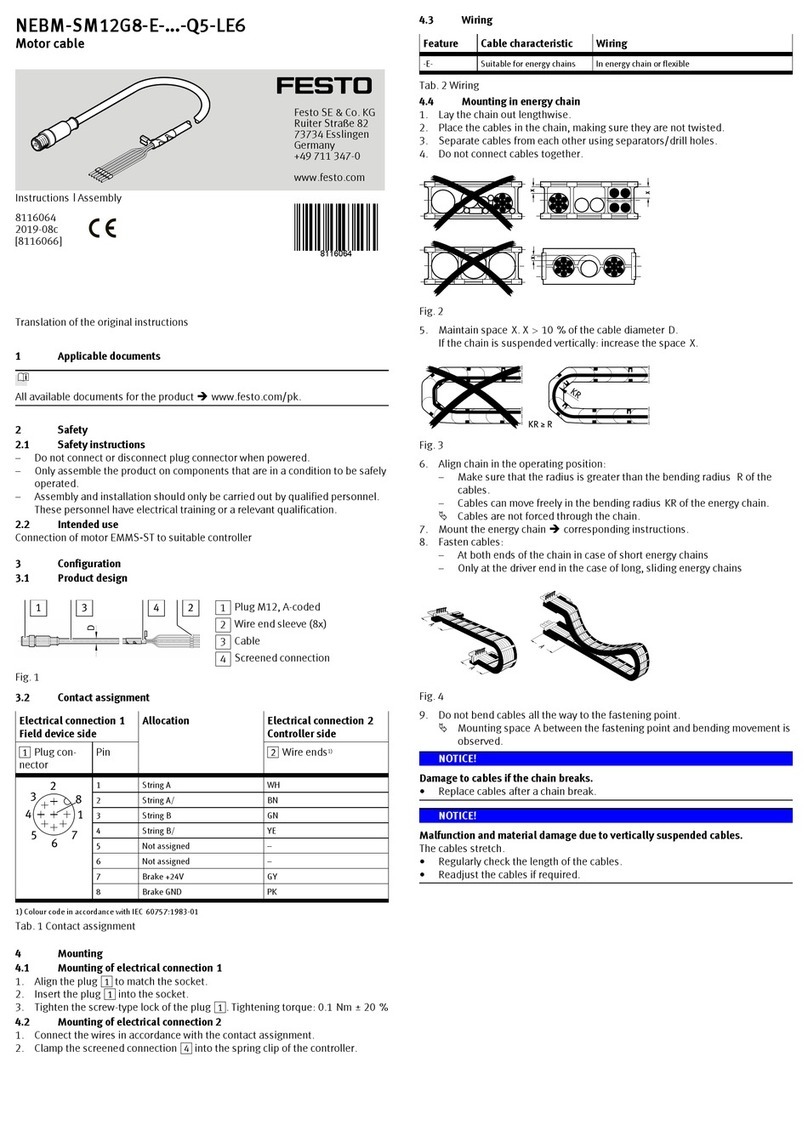
Festo
Festo NEBM-SM12G8-E Q5-LE6 Series Instructions & assembly
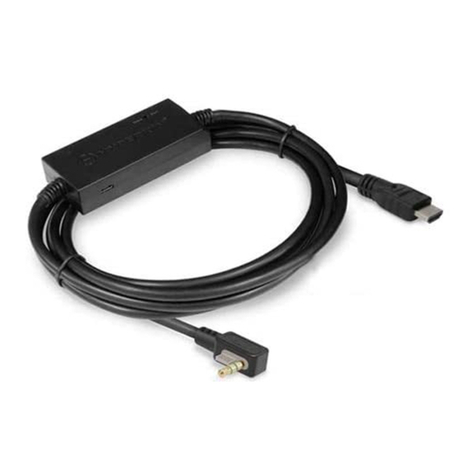
Hyperkin
Hyperkin M07409 quick start guide
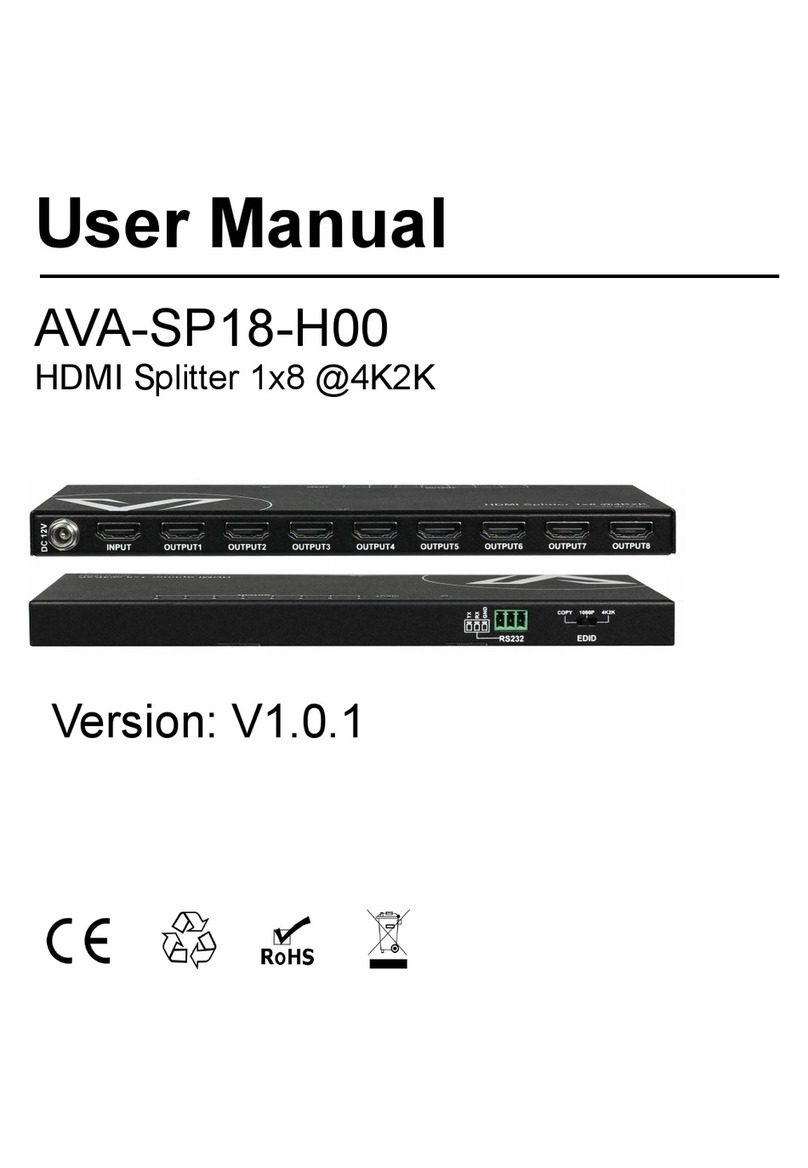
AV Access
AV Access AVA-SP18-H00 user manual

Colorado Video
Colorado Video 613gs instruction manual

Leviton
Leviton black & white 3762 installation instructions
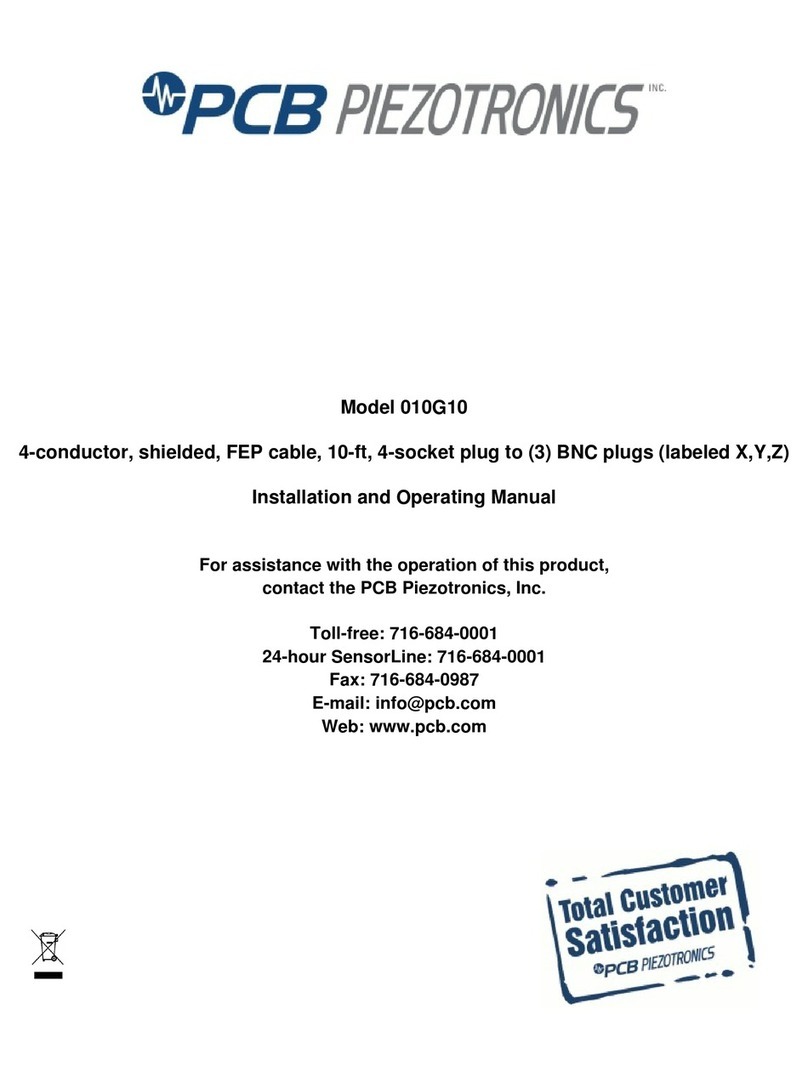
PCB Piezotronics
PCB Piezotronics 010G10 Installation and operating manual

Lenze
Lenze L-force EWS Mounting instructions
